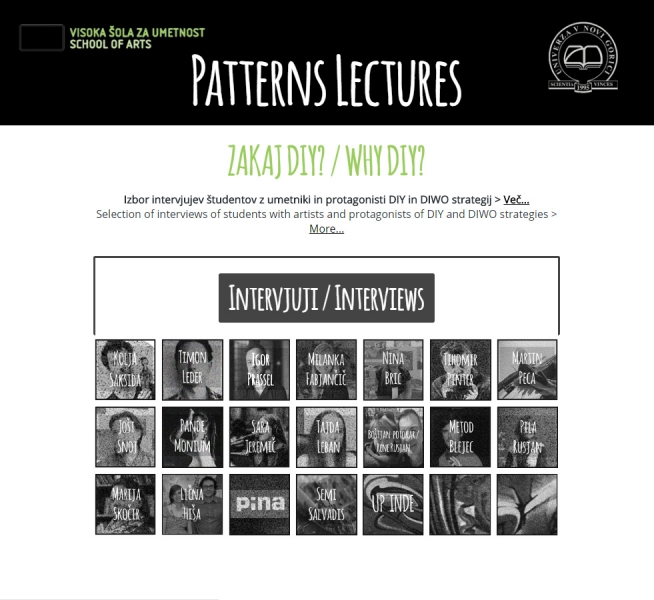2016 – 2014
D.I.W.O. art systems: corrections to the dominant yet deficient system and narrative of visual art in Slovenia, 1960–2000
Why DIY?/Zakaj DIY? >> A selection of interviews of students with artists and protagonists of DIY and DIWO strategies
More on field trip to visit OHO’s Marko Pogačnik and BridA (April 2015)
Public lectures of Barbara Borčič and Eduard Freudmann (November 2014)
Today with certain DIY and DIWO movements, seeming powerlessness of subjects becomes the base from which action is sustained, rather than a ground for its postponement. With the collapsing of the social state all over Europe searching for various ways for the people to sustain and exercise their power within the realm of national states and EU is more and more important.
The course will pinpoint, register and analyse DIY and DIWO art practices and translate that to students. The time span ranges from the sixties when DIWO practices became visible due to various movements in the international currents and partially as a response to the specific regional situations. Different segments (initiators, authors, inventory and timelines, methodology and tactics, influence on the art practice and art policies…) of DIY and DIWO art practices will be analysed and contextualised within the art system.
Taking Slovenia as the location of the case study is a statement of having an “identity embedded in local circumstances and a role in the global dialogue.” (Osterweil 2004, 113). The specificity of Slovene art scene in the 80’s and 90’s was that its actions were mostly constructive and did not intend to harm the system but change it, to work to their own accord (see: Petrešin). The Slovene artists: Irwin, P.A.R.A.S.I.T:E. museum, Državica Ptičjestrašilna, Cirkulacija, DDR … will be researched with the help of live interviews with the protagonists.
In Yugoslavia the state art system, reformed in the times of the Worker self-management, soon showed major deficiencies, as did the historization of the art practices. Perhaps that is why, regional’s art practices were defined with DIY and DIWO strategies of self-organization, self-historization and self-archiving. Present in the (financially poor and structurally weak) art system from its beginnings, these practices especially sprung to view in the art of the eighties, a time of conceptualization of a new state of Slovenia, when the whole multinational state system begun to crumble and new generations felt this burden the hardest.
Perhaps the most prominent example of this period is the East Art Map which with the efforts of the Irwin group even succeeded in becoming a tool that transformed urban legends and stories of the art world in Eastern part of Europe into the mainstream discourses of (world) art history.
The DIY and DIWO art practices will be analysed on the regional case studies and in a specific geo political context. The practices as we see them, are connected with the formation of the new state Slovenia but the influences of the Yugoslav system and socialism should not be neglected.
Project leader: dr. Petja Grafenauer
Main guest lecturer: Saša Nabergoj
Assistant: Simona Žvanut
The language of the subject: English and Slovene language
Patterns lectures in 2014/15:
Guest lecturers: Barbara Borčić, Eduard Freudmann
Public lectures of Barbara Borčič and Eduard Freudmann (November 2014)
Study Excursion: OHO’s Marko Pogačnik and BridA (April 2015)
Final students’ assignment: to perform an interview with artist/artist groups who are using DIY and DIWO strategies at their artistic practice. Students could decide upon the format, methodology and media of the presentation.
Patterns lectures in 2015/16
The Patterns courselet was concluded with an online publication of students interviewing selected DIY/DIWO artists and other protagonists of the cultural scene. Students prepared the concept of the publication in the form of a group work under mentorship, including design work and an editorial. As such, they tested their D.I.Y. and D.I.W.O. strategies and practices in practice. See the link below for the publication:
Why DIY?/Zakaj DIY? >> A selection of interviews of students with artists and protagonists of DIY and DIWO strategies
interviewees & interviews done by:

Kolja Saksida, intervju pripravil: Miha Oven, DUP 2
Timon Leder, intervju pripravil: Samo Bihar, MAP 1
Igor Prassel, intervju opravil: Damir Grbanović, MUP 1
Milanka Fabjančič, intervju pripravil: Filip Bihar, MAP 1
Nina Bric, intervju pripravile: Sara Stankovič, Neva Kumelj, Mateja Nikolić, DUP 2
Tihomir Pinter, intervju pripravila: Taja Košir Popovič, DUP 2
Martin Peca, intervju pripravila: Noemi Zonta, DUP 3
Jošt Snoj, intervju pripravil: Miha Zaletel, DUP 3
Pandemonium, intervju opravil: Jaka Čurlič, DUP abs.
Sara Jeremič, intervju pripravil: Matej Turk, DUP 2
Tajda Leban, intervju pripravil: Tilen Leban, DUP 3
Boštjan Potokar & Rene Rusjan, interview prepared by: Rawan F. A. Alhourani, MUP 1
Metod Blejec, interview prepared by: Helene Thümmel, MUP 1
Pila Rusjan, interview prepared by: Sandra Jovanovska, MUP 1
Marija Skočir, intervju pripravila: Vida Habjanič in Benjamin Friškovec, DUP 2
Lična hiša, intervju pripravila: Anne Tassel, DUP 2
Pina, intervju opravila: Katja Munda Rakar, MUP 1
Semi Salvadis, interview prepared by: Roberta Battiston, DUP3
Up Inde, intervju pripravila: Noemi Zonta, DUP 2





